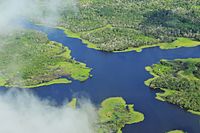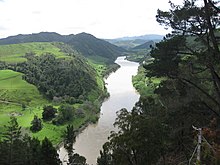| Part of a series on |
| Rights of nature |
|---|
 |
| Movements and schools of thought |
| Traditional worldviews |
| Scholars and authors |
| Other |
Rights of nature law is the codification and other implementations of the legal and jurisprudential theory of the rights of nature. This legal school of thought describes inherent rights as associated with ecosystems and species, similar to the concept of fundamental human rights.[1][2][3][4]
The early 2000s saw a significant expansion of rights of nature law, in the form of constitutional provisions, treaty agreements, national and subnational statutes, local laws, and court decisions.[5] As of 2022, nature's rights laws exist at the local to national levels in 39 countries,[6][7][8][9][10] including in Canada,[11] at least seven Tribal Nations in the U.S. and Canada, and over 60 cities and counties throughout the United States.[7][12][13][14] The total number of initiatives was 409 as of June 2021.[15][7][5][9] The EcoJurisprudence Monitor lists over 500 as of early 2024.[1]
- ^ Cite error: The named reference
Cullinan 2011was invoked but never defined (see the help page). - ^ Cite error: The named reference
Berry 1999was invoked but never defined (see the help page). - ^ Cite error: The named reference
Stone 1996was invoked but never defined (see the help page). - ^ Cite error: The named reference
Nash 1989was invoked but never defined (see the help page). - ^ a b Cite error: The named reference
Kauffman 2020was invoked but never defined (see the help page). - ^ Putzer, Alex; Lambooy, Tineke; Jeurissen, Ronald; Kim, Eunsu (2022-01-01). "Putting the rights of nature on the map. A quantitative analysis of rights of nature initiatives across the world". Journal of Maps. 18 (1): 89–96. Bibcode:2022JMaps..18...89P. doi:10.1080/17445647.2022.2079432. hdl:11382/550531. ISSN 1744-5647.
- ^ a b c Cite error: The named reference
Kauffman Sep 2022was invoked but never defined (see the help page). - ^ Cite error: The named reference
Sheehan April 2020was invoked but never defined (see the help page). - ^ a b Cite error: The named reference
United Nations, Harmony with Nature - list of initiativeswas invoked but never defined (see the help page). - ^ Cite error: The named reference
Kauffman 2021was invoked but never defined (see the help page). - ^ Cite error: The named reference
Reuters 2021was invoked but never defined (see the help page). - ^ a b Cite error: The named reference
Kauffman & Sheehan 2019was invoked but never defined (see the help page). - ^ Cite error: The named reference
Houck 2017was invoked but never defined (see the help page). - ^ Cite error: The named reference
Boyd 2017was invoked but never defined (see the help page). - ^ Putzer, Alex; Lambooy, Tineke; Jeurissen, Ronald; Kim, Eunsu (2022-01-01). "Putting the rights of nature on the map. A quantitative analysis of rights of nature initiatives across the world". Journal of Maps. 18 (1): 89–96. Bibcode:2022JMaps..18...89P. doi:10.1080/17445647.2022.2079432. hdl:11382/550531. ISSN 1744-5647.
- ^ Cite error: The named reference
Kauffman & Martin 2019was invoked but never defined (see the help page). - ^ Cite error: The named reference
Magallanes & Sheehan 2017was invoked but never defined (see the help page). - ^ Cite error: The named reference
Cheng 2017was invoked but never defined (see the help page). - ^ Cite error: The named reference
Roy 2017was invoked but never defined (see the help page).

